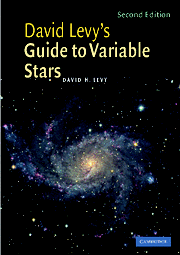Preface
Published online by Cambridge University Press: 05 August 2012
Summary
What do you see when you look through a telescope? Is it the mountains and valleys of a lunar highland, or perhaps a thinly veiled Jovian storm? Or do you prefer the ghostly light of the distant galaxies, island universes adrift in a sea of space and time? Perhaps you see the fluctuations of stars in our galaxy, stars of all ages whose nightly appearance changes according to some cosmic drumbeat whose rhythm we try to unravel.
A variable star is simply a star that changes in brightness. Observing variable stars is both useful to science, and fun. It is a field that needs the observations that dedicated amateurs with small telescopes have the time and enthusiasm to make. It will reciprocate as you contribute to it, for the more you observe the more you will learn about your subjects of observation.
The purpose of this book is to inspire you to observe variable stars. Through its pages, I want to share my enthusiasm for these distant suns that change in brightness. Accordingly the book's approach is to emphasize the observing, and to keep the scientific explanations simple.
Why do variables attract us? The answer lies in the stars themselves. These innocuous objects attract our interest because of their behavior, not their appearance. Although they do not look fascinating at first glance, consistent watching will draw out their surprises.
- Type
- Chapter
- Information
- David Levy's Guide to Variable Stars , pp. xi - xiiiPublisher: Cambridge University PressPrint publication year: 2005

